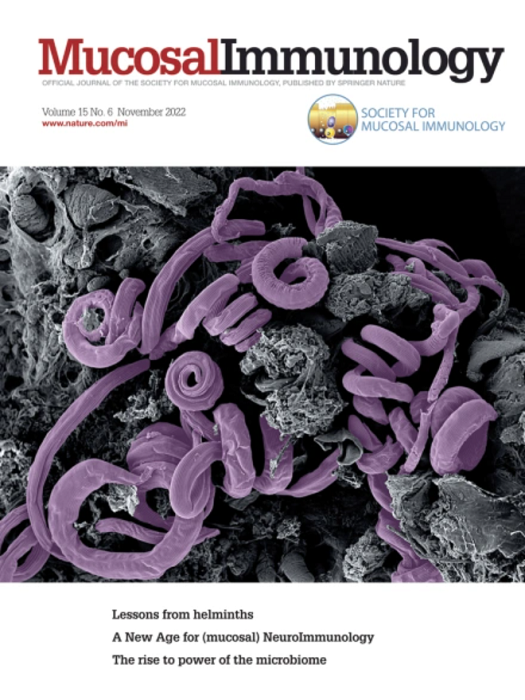Single-cell sequencing reveals the same heterogeneity of neutrophils in heatstroke-induced lung and liver injury
IF 7.6
2区 医学
Q1 IMMUNOLOGY
引用次数: 0
Abstract
Heatstroke (HS) is typically considered a sepsis-like syndrome caused by hyperthermia, often accompanied by multiple organ dysfunctions (MODS). To explore the mechanisms of MODS, we established a mouse model of HS by exposing mice to a hyperthermic and high-humidity environment. Then, we utilized single-cell RNA sequencing (scRNA-seq) to depict the cellular landscape of HS mice lung tissue and liver tissue. We found that the enhancement of neutrophil infiltration mediated by the “Cxcr2-Cxcl2″ receptor-ligand pair is a prominent feature of HS-induced lung injury. By effectively suppressing the recruitment of neutrophils in HS-induced lung injury, the application of Cxcr2 inhibitor held positive implications for improving HS-induced lung injury. In addition to the chemotactic effect of immune cells on neutrophils, we identified a subcluster of fibroblasts labeled as Col14a1+, which possessed notable chemotactic factor-secretion characteristics and likely exerted a role in the early stages of neutrophil infiltration. Furthermore, our study unveiled significant heterogeneity among neutrophils within the HS-induced lung injury. Particularly, Cd177 + neutrophils exhibited a dominant presence, characterized by heightened pro-inflammatory responses and oxidative stress. In heatstroke-induced liver injury, neutrophils exhibited similar heterogeneous characteristics. Cd177 + neutrophils exhibited an enhanced ability to produce neutrophil extracellular traps (NETs) while lowering the levels of NETs can significantly improve heatstroke-induced lung and liver injury. Additionally, our study identified Cebpe as a key transcriptional regulatory factor in Cd177 + neutrophil differentiation. Knockdown of the expression of Cebpe can suppress the Cd177 + neutrophil differentiation and decrease the expression levels of NETs. Our research indicated a common heterogeneity in neutrophils during MODS in HS. Cd177 + neutrophils contributed to organ damage in HS, and Cebpe may serve as a crucial intervention target in the treatment of HS.
单细胞测序揭示了中性粒细胞在中暑引起的肺和肝损伤中的异质性。
中暑(HS)通常被认为是一种由高温引起的败血症样综合征,通常伴有多器官功能障碍(MODS)。为了探讨MODS的发生机制,我们将小鼠置于高温高湿环境中,建立小鼠HS模型。然后,我们利用单细胞RNA测序(scRNA-seq)描绘了HS小鼠肺组织和肝组织的细胞景观。我们发现“Cxcr2-Cxcl2″受体-配体对”介导的中性粒细胞浸润增强是hs诱导肺损伤的一个突出特征。通过在hs诱导的肺损伤中有效抑制中性粒细胞的募集,Cxcr2抑制剂的应用对改善hs诱导的肺损伤具有积极意义。除了免疫细胞对中性粒细胞的趋化作用外,我们还发现了一个标记为Col14a1+的成纤维细胞亚群,它具有显著的趋化因子分泌特征,可能在中性粒细胞浸润的早期阶段发挥作用。此外,我们的研究揭示了hs诱导的肺损伤中中性粒细胞的显著异质性。特别是,Cd177 + 中性粒细胞表现出优势存在,其特征是促炎反应和氧化应激升高。在中暑引起的肝损伤中,中性粒细胞表现出类似的异质性特征。Cd177 + 中性粒细胞表现出增强的产生中性粒细胞胞外陷阱(NETs)的能力,而降低NETs的水平可以显著改善中暑诱导的肺和肝损伤。此外,我们的研究发现Cebpe是Cd177 + 中性粒细胞分化的关键转录调节因子。下调Cebpe表达可抑制Cd177 + 中性粒细胞分化,降低NETs表达水平。我们的研究表明,在HS MODS期间中性粒细胞具有共同的异质性。Cd177 + 中性粒细胞参与HS的器官损伤,Cebpe可能是治疗HS的关键干预靶点。
本文章由计算机程序翻译,如有差异,请以英文原文为准。
求助全文
约1分钟内获得全文
求助全文
来源期刊

Mucosal Immunology
医学-免疫学
CiteScore
16.60
自引率
3.80%
发文量
100
审稿时长
12 days
期刊介绍:
Mucosal Immunology, the official publication of the Society of Mucosal Immunology (SMI), serves as a forum for both basic and clinical scientists to discuss immunity and inflammation involving mucosal tissues. It covers gastrointestinal, pulmonary, nasopharyngeal, oral, ocular, and genitourinary immunology through original research articles, scholarly reviews, commentaries, editorials, and letters. The journal gives equal consideration to basic, translational, and clinical studies and also serves as a primary communication channel for the SMI governing board and its members, featuring society news, meeting announcements, policy discussions, and job/training opportunities advertisements.
 求助内容:
求助内容: 应助结果提醒方式:
应助结果提醒方式:


